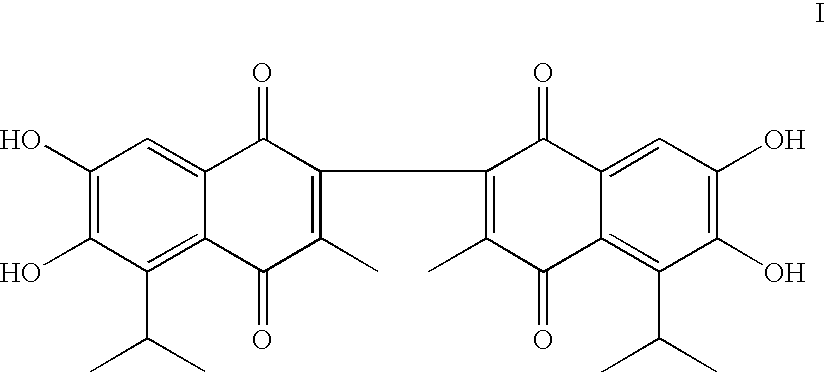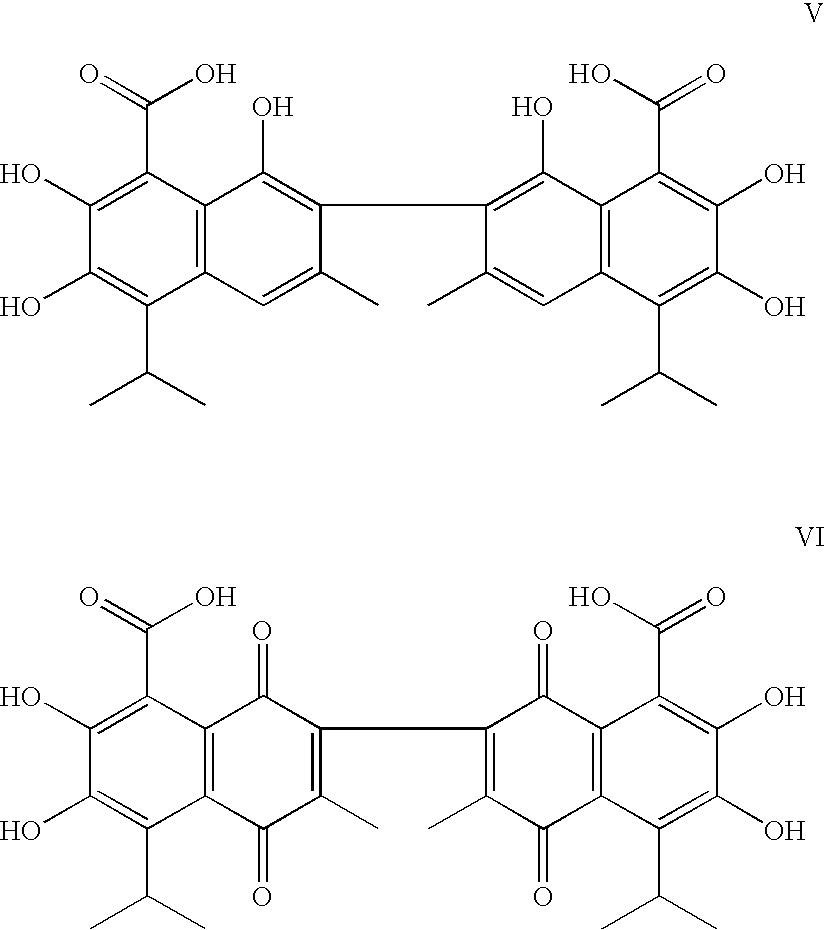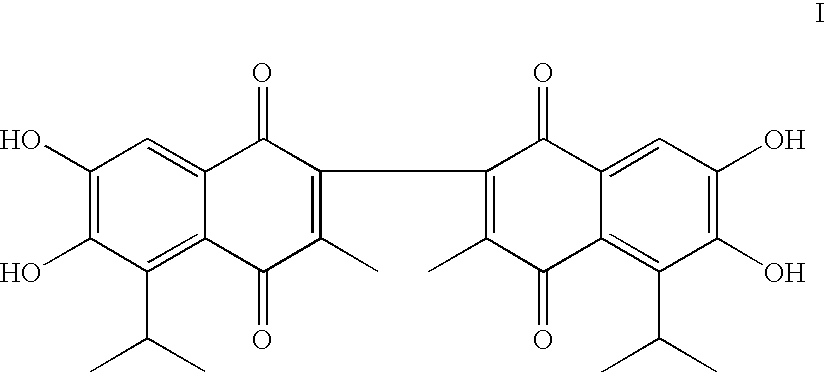Apogossypolone and the uses thereof
a technology of apogossypolone and a compound, applied in the field of medicinal chemistry, to achieve the effect of less toxic, less toxic, and greater tumor response and clinical benefi
- Summary
- Abstract
- Description
- Claims
- Application Information
AI Technical Summary
Benefits of technology
Problems solved by technology
Method used
Image
Examples
example 1
Fluorescence Polarization Binding Assay
[0098] Fluorescence polarization (FP)-based binding assays for Bcl-2 and Bcl-xL were developed and optimized using recombinant human Bcl-2 and Bcl-xL proteins, a Bid BH3 peptide labeled with 6-carboxyfluorescein succinimidyl ester (FAM) and Bak BH3 peptide labeled with 6-(fluorescein-5(6)-carboxamido) hexanoic acid (Flu). The FP-based binding assays measure the ability of an inhibitor to displace either Bid-FAM or Bak-Flu peptide from Bcl-2 or Bcl-xL protein, respectively. The dose-dependent binding experiments were carried out with serial dilutions of the tested compounds in DMSO. For the Bcl-2 binding assay, a 5 μl sample of the inhibitor and preincubated recombinant His-fused soluble Bcl-2 protein (120 nM) with Bid-FAM peptide (10 nM) in the assay buffer (100 mM potassium phosphate, pH 7.5; 100 μg / ml bovine gamma globulin; 0.02% sodium azide, purchased from Invitrogen, Life Technologies), were added in Dynex 96-well, black, round-bottom pla...
example 2
Design of Gossypol Analogs
[0099] (−)-Gossypol has been shown to bind to Bcl-2 and Bcl-xL at the BH3 binding groove and to have significant anticancer activity (U.S. Patent Application No. 2003 / 0008924). (−)-Gossypol contains two reactive aldehyde groups in its structure. These two reactive groups form Schiffs bases with lysine residues in proteins and have been attributed to the toxicity of gossypol in animals and humans. This toxicity, albeit mild, limits the maximum dose that can be given to patients. Extensive efforts were utilized to identify gossypol analogs that are both less toxic and bind more tightly to Bcl-2.
[0100] Two analogs, gossypolic acid (V) and gossypolonic acid (VI), were designed to maintain the interaction between the aldehyde group and an arginine residue in Bcl-2 and Bcl-xL (Arg-139 and Arg-141, respectively). These two compounds were determined to have Ki values of 120 nM and 280 nM, respectively, i.e., slightly more potent than (−)-gossypol. However, the tw...
example 3
Cell Growth Inhibition Activity of Apogossypolone
[0102] A direct comparison of (−)-gossypol, apogossypol and apogossypolone for their activity in inhibition of cell growth in PC-3 and LnCap prostate cancer cell lines was carried out. In 3-5 independent experiments, apogossypol was as potent as (−)-gossypol, while apogossypolone (IC50=2.2 μM) was consistently 3-4 times more potent than (−)-gossypol (IC50=6.5 μM) in inhibition of cell growth in a 4-6 day MTT assay in the PC-3 cell line. Similar results were found with the LnCap cell line (apogossypolone IC50=1.3 μM, (−)-gossypol IC50=4.7 μM). However, apogossypol was very unstable and the sample rapidly decomposed within 1 week even stored at −20° C. and under nitrogen. In contrast, apogossypolone was very stable; no decomposition was detected when it was stored at room temperature for several weeks without the protection of nitrogen.
[0103] Additional cell growth inhibition studies were performed using the MDA-MB-231 (subclone 2LMP)...
PUM
| Property | Measurement | Unit |
|---|---|---|
| enantiomeric excess | aaaaa | aaaaa |
| volume | aaaaa | aaaaa |
| pH | aaaaa | aaaaa |
Abstract
Description
Claims
Application Information
 Login to View More
Login to View More - R&D
- Intellectual Property
- Life Sciences
- Materials
- Tech Scout
- Unparalleled Data Quality
- Higher Quality Content
- 60% Fewer Hallucinations
Browse by: Latest US Patents, China's latest patents, Technical Efficacy Thesaurus, Application Domain, Technology Topic, Popular Technical Reports.
© 2025 PatSnap. All rights reserved.Legal|Privacy policy|Modern Slavery Act Transparency Statement|Sitemap|About US| Contact US: help@patsnap.com



